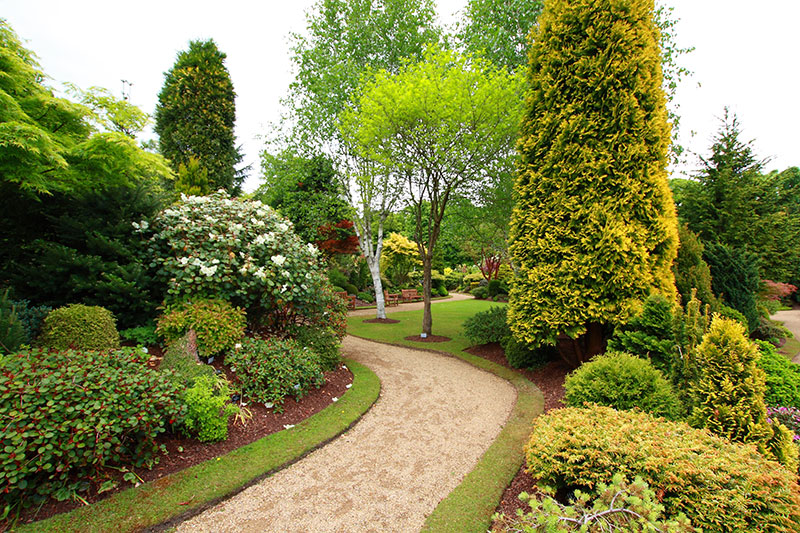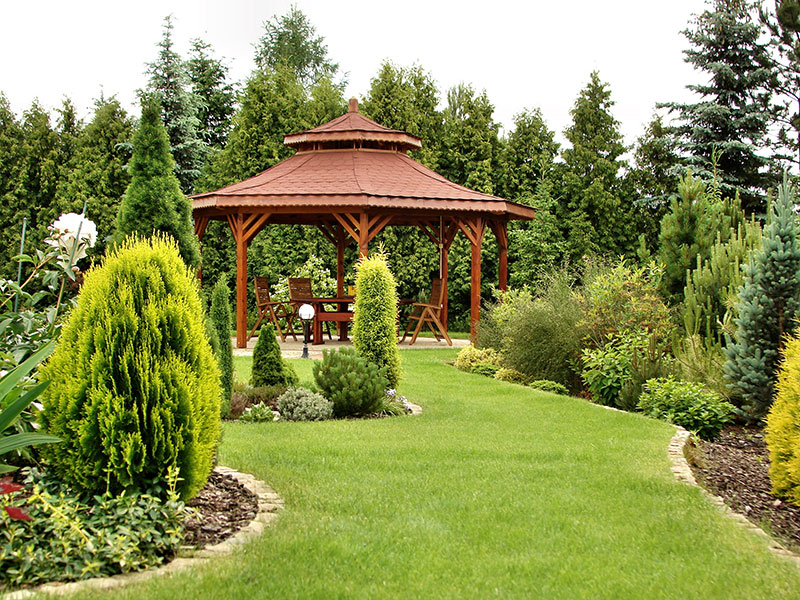REGULAR LAWN MAINTENANCE
As the dominant feature of most landscape designs, the lawn requires particular attention. These days, more and more people are turning to environmentally-friendly maintenance practices to obtain a dense, healthy, high-quality lawn.
Practice good maintenance and you will be rewarded with a beautiful lawn works that can resist stresses like drought, without resorting to chemical fertilizers and pesticides. Learn the importance of good mowing practices, proper watering techniques, how to fertilize effectively, the differences between various fertilizers, and the type of accessories you’ll need, from a hose to a spike sprinkler.
MOWING
Good lawn maintenance will reward you with a healthy and vigorous lawn with deep roots. If you follow mowing height guidelines, your lawn will be more resistant to drought, heat and weeds.
The main lawn-mowing rules are:
- Mow regularly, provided no more than one third of the grass blade is removed in a single mowing.
- Adjust mowing height in accordance with seasonal guidelines.
- Sharpen blades regularly, since a clean cut promotes recovery and reduces the risk of diseases.
- Practice grass cycling: leave grass clippings on the lawn! Grass clippings are a significant source of nutrients for organisms in the soil that are beneficial to your lawn. If you follow mowing height guidelines, grass clippings will decay quickly and won’t affect the appearance of your lawn. Think of grass clippings as 100% natural fertilizer for your Louisville Landscaping. And, you’ll be able to cut down your fertilizer use by up to 25%. To accelerate the decomposition of clippings by microorganisms in the soil, opt for a mulching mower which grinds clippings on site.
- Rake up grass clippings that are too long or heavy to leave on the lawn; put them in the compost or spread them evenly over the lawn.
- Avoid mowing when grass is damp or too wet.
- Avoid mowing when the soil is too moist; you risk compacting the soil.
Mowing height: seasonal guidelines
Spring and fall: For your first mowing in the spring when you are cleaning up the lawn after the winter, adjust the height of the blades to 5 cm, and then raise the height to 8 cm. In the fall, your last Terrace Landscaping should be at 5 cm as well, which will reduce the risk of disease.
Summer: Maintain mowing height at 8 cm; longer grass will be more drought-resistant and therefore require less watering. Do not mow during periods of high heat and drought.

WATERING
Many people feel and act as though water supplies are endless. They aren’t, and many municipalities have to deal with drought conditions on a regular basis. Lawn watering in summer is regulated in many areas, which can involve the installation of water meters.
According to the Matthews Lawn Service the lawn water conservation can be promoted by adopting these good practices:
- Keep your mower blades at 8 cm during the summer. Longer grass encourages deeper roots, which helps the soil retain moisture and increases the lawn’s resistance to drought.
- Water early in the morning or in the evening when temperatures are cooler and there is less wind; you will lose less water to evaporation.
- Let water penetrate 10 to 15 cm. Check after one or two hours. Avoid light and frequent watering; this simply encourages surface roots to develop making your lawn more vulnerable to drought.
- Use an electronic timer to avoid water loss and to turn your sprinklers on and off automatically.
- During periods of hot weather in the summer and when the soil is dry, the lawn will stop growing and turn a yellowish colour. Don’t panic, your lawn is not dying; it will soon green up again when it rains.
When you go to purchase your lawn accessories, make your life a lot easier by opting for accessories that are made of tough, shock-resistant materials that require no maintenance, are leak-proof and won't corrode.
Here are a few accessories that can facilitate watering:
- A spike sprinkler is ideal for even irrigation and wider coverage.
- Hoses are available in a wide variety to cover everyone’s needs, from an all-weather hose for weekend gardening to an ultra-flexible hose for the frequent gardener.
- A hose reel will prolong the life of your hose by keeping it rolled up and out of the way when not in use. You can choose between a cart or wall-mount version. To install a wall-mount hose reel, use a carbon drill bit to drill the fastening-screw holes into the foundation. Use a 5/32'' drill bit for 3/16'' Tapcon screws, or a 3/16'' drill bit for ¼'' Tapcon screws. Make sure the hole you drill is the same length as the screws you’re using.
- An automatic sprinkler system is useful and can actually save water if properly monitored.
- An electronic water timer saves time and waters lawns efficiently without wasting water.

FERTILIZING
Turf grasses, like any other plants, require certain minerals for healthy growth. A strong and vigorous lawn is less vulnerable to weeds.
It’s important to be familiar with certain cultivation practices before you select a fertilizing programme. Remember that topdressing and grasscycling can provide your lawn with approximately 25% of the nitrogen it requires, a cost-saving practice that reduces the amount of fertilizer you will need to apply.
For an eco-friendly lawn, opt for natural fertilizers instead of chemical fertilizers. These naturally-based lawn fertilizers can be made of bone meal, blood meal, feather meal, seaweed, or manure. A corn gluten-based fertilizer has also been available for the past number of years; in addition to providing nitrogen (the first number on the fertilizer list), it reduces the number of weeds such as dandelions and broad-leaved plantain on the lawn. Corn gluten works by preventing roots from forming as the seeds of weeds are germinating. However, if you have overseeded your lawn, do not use corn gluten-based fertilizer because it might hinder the growth of your grass seed.
How natural fertilizers work
Most natural fertilizers release their nutrients throughout the season by means of beneficial soil organisms. In addition to feeding the lawn, these fertilizers stimulate biological life in the soil and present zero risk of burns.
In the spring, use a fertilizer with more nitrogen; this means that the first number should be higher than the other two (i.e. 12-0-4 or 9-3-4). In late-summer and fall, you should use a fertilizer with a higher potassium content (i.e. 4-0-12), to prepare the lawn for the rigours of winter. Read the manufacturer’s instructions carefully and adhere to recommended quantities.
When you should fertilize
Using a natural granular fertilizer generally requires one or two applications per year. The first application should be done in the spring when grass is starting to grow and growth is at its most vibrant. If necessary and indicated on the manufacturer’s label, the second application should be done late summer to early fall
How natural granular fertilizers should be applied
Granular fertilizers should be applied using a Workone New Albany fertilizer spreader (broadcast spreader) on dry and freshly-mown lawn. The spreader is easy to use and allows for an even distribution over the entire lawn surface. It can also be used for liming or for seeding. Choose a model equipped with a safety stop to avoid spillage and a flow control regulator to adjust quantities. The size of the tray varies from one model to another but be sure it’s suitable for the type of fertilizer you plan to use and for the size of your yard. Whichever fertilizer you choose, always follow the instructions on the label and apply the correct quantities. To ensure equal distribution, spread half the recommended dose in one direction and the other half in the other direction.
Before using soil conditioners, pesticides or fertilizers, read the instructions on the product label very carefully. Pay special heed to warnings and follow the necessary precautions before, during and after using the product. Storage requirements are also important.